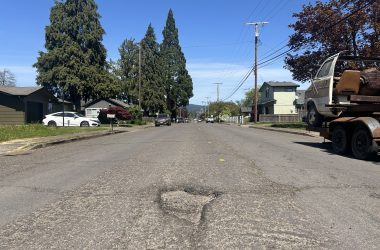As spring has taken over and pollen counts are increasing, allergy season is quickly approaching.
It’s estimated that more than 50 million Americans struggle with seasonal and environmental allergies, and Dr. Kraig W. Jacobson, a Eugene-based allergist with Oregon Allergy Associates (OAA), said experts have noticed the pollen season begins about two weeks earlier than it did previously.
“We used to say ‘from Memorial Day to Fourth of July,’” Jacobson commented regarding peak allergy season. “Now you can add about 10 days to that.”
What is a pollen count?
It’s widely understood that the pollen in the air causes many common allergy symptoms such as itchy, watery eyes and sneezing, but the actual science behind calculating pollen is not often discussed.
Jacobson is responsible for performing the pollen count on each weekday for OAA. He begins at 6 a.m., and the process takes about two hours.
The process to calculate the daily pollen count is quite complicated as it requires Jacobson to analyze the pollen which makes its way from the air and into a vacuum pump, and then he must perform microscopic identification. But the process ultimately results in two sets of data: one for grass pollen and one for tree pollen. These two pollen counts are then posted on the OAA website with a paragraph from Jacobson to explain what the numbers mean.
For example, on April 8, Jacobson posted that the grass pollen count was zero and low while the tree pollen count was 142 and high. The denotations for the pollen count have four categories: low, moderate, high, and very high. He suggested that the tree pollen’s count was high due to the drier weather, and as the weather continues to warm up, the tree pollen count should continue to increase.
Why is Oregon unique?
To provide context to the numbers, Jacobson compared data he has collected in other states to the data he now collects in Eugene.
“I did my allergy fellowship in Denver, and that’s where we learned to do the counts. When we did the counts there, a high day would be around 100 – that’s true if you go to Seattle, and if you go to other cities in California that don’t have entrapped valleys like this, it’s going to be 100-150 maximum in those areas,” Jacobson said. “But last year, our peak was 1,308, so we’re far above what other areas have for grass pollen exposure.”
The entrapped valley he is referring to is the Willamette Valley.
“The pollen gets much higher in the atmosphere. It builds over a period of time, so it creates a much bigger blanket in the Willamette Valley, and the valley acts as a catcher’s mitt because the wind is usually out of the north toward the south,” he said.
Further, Jacobson said 80% of the ryegrass seed throughout the world is grown in the Willamette Valley, “and anything that goes to seed has to go to pollen first. You have to have the pollen complete that cycle to make the seed that you plant.” This is why Linn County is referred to as The Grass Seed Capital of the World.
Allergy treatment
Dr. Maxwell Li, a board certified allergist-immunologist at OAA, said there are three tiers to consider when preparing for allergy season.
• Tier one revolves around avoidance strategies such as keeping windows closed or using HEPA filters indoors or wearing masks “to prevent the inhalation of pollen” if you need to go outdoors. On this note, Jacobson recommended people wear glasses outdoors since eyes and eyelashes are good at picking up pollen.
• Li’s second tier is when he recommends medications. “We usually recommend long-acting, over-the-counter antihistamines to help with nasal and eye symptoms,” Li said.
He recommended nasal washes to wash away mucus or any other allergens in the nose and mentioned two different types of nasal sprays which are over the counter: nasal steroids, like Flonase or Nasacort which “helps decrease inflammation in the nose,” and nasal antihistamines, like Astepro which “blocks an allergy receptor in the nose.” Li also recommended people use antihistamine eye drops.
• Tier three is when allergy symptoms become serious enough that people should see an allergist and get an evaluation. He said, “if you’re still having symptoms after using these medications, the last thing is allergen immunotherapy.” There are a couple options which people can discuss with their doctors such as traditional therapies like allergy shots and other options such as allergy tablets.








